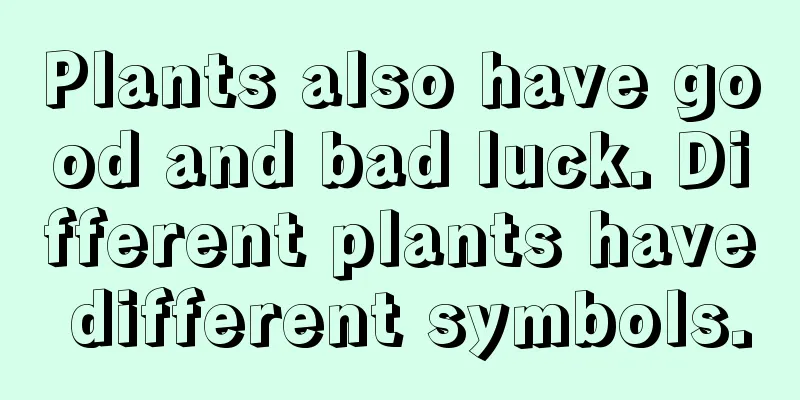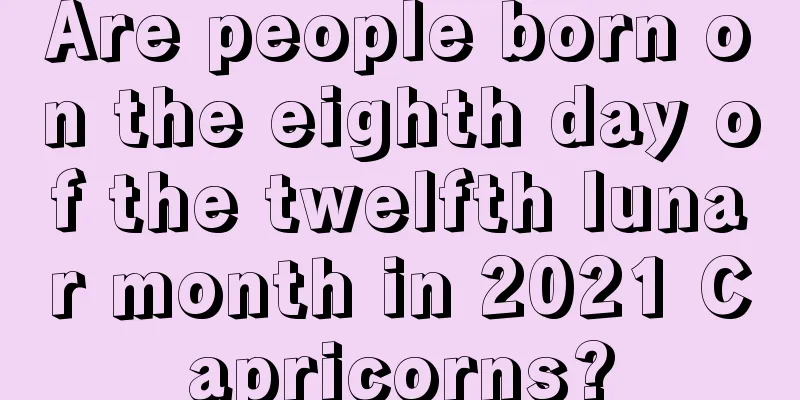Plants also have good and bad luck. Different plants have different symbols.

|
Introduction: We often say that we put some plants at home or in the office to make it look better. In fact, many of them are considered from the perspective of Feng Shui. In the application of Feng Shui, plants are often used to bring good luck and ward off evil, so different plants are given different meanings. So today I will talk to you about the auspiciousness, inauspiciousness and symbols of plants. For reference! Feng Shui is a professional term in Feng Shui. Let us take a look at the knowledge of Feng Shui below. 1. Plants Considered Auspicious1. Orange: “Orange” is homophonic with “lucky”, which means luck. Therefore, potted citrus plants have become a household decoration during the Spring Festival. 2. Auspicious grass: Auspicious grass is small, green all year round, and grows easily in mud and water. It symbolizes "good luck" and is also called auspicious grass. 3. Chinese toon: Chinese toon is easy to grow and long-lived. In some places, the custom of touching Chinese toon trees is popular. On New Year’s Eve, children would touch the toon tree and circle around it a few times, praying to grow taller quickly. In some places, on the morning of the first day of the first lunar month, children hug the toon tree and recite "Toon tree, Toon tree, you are the king, you grow thicker and I grow taller." 4. Sophora tree: It is believed to represent "lu". In ancient times, the imperial court planted three locust trees and nine thorn trees. The dukes and officials sat under the trees. Those facing the three locust trees were called the Three Dukes. Later, locust trees were planted in courtyards. 5. Peach tree: It is said to be the essence of the five elements and can ward off evil spirits, so peach charms are hung on doors during the New Year. 6. Willow: It has the same function as the peach tree. Willow branches can be inserted at the door to ward off evil spirits. 7. Gourd: In Feng Shui, gourd is considered to be a plant that can drive away evil spirits, and the ancients often planted it in front of and behind their houses. Modern physical tests have proved that the "treasure gourd" shaped vessel can shield interference from various waves and radiation. 2. Plants Considered to Be Bad Omens1. Eucalyptus: This "giant" tree can grow to more than twenty stories high like a building. Young and middle-aged people dare not plant it because it is said that if the tree grows too big, the person will die. To plant this tree, you have to ask an elderly person to do it. Even if the tree grows big, the planter will almost die. 2. Feng Shui Trees: In the south, some villages still have a small area of lush forests nearby, most of which are evergreen trees such as camphor, pine, cypress, and nanmu. As a tourist, please don't touch them. Because this is a Feng Shui tree, also called a water mouth tree. Even though it is just a small piece of green forest, it is related to the Feng Shui lifeline of the entire village. Local people dare not touch any grass or tree there, for fear of destroying the Feng Shui of the village. |
<<: Pay attention! These Feng Shui will bring you bad luck at the end of the year
>>: Feng Shui helps you lose weight. Analysis of weight loss techniques in home Feng Shui
Recommend
What is the zodiac sign of people whose birthdays are on Christmas Day 2020? Is it good to be born on the same day?
Christmas has always been a wonderful holiday. Thi...
Which days in the Ghost Month of the seventh lunar month in 2020 are suitable for signing contracts and making money?
Introduction: Signing a contract is one of the imp...
What is the date of April 12th in the Gregorian calendar in 2020? Is it a good day?
The Gregorian calendar and the lunar calendar are...
What activities does the She ethnic group have on March 3rd? What should we pay attention to on March 3rd?
What activities does the She ethnic group have on ...
Is it not appropriate to have sex on Christmas Day in the eleventh month of winter in 2020? Is the hexagram on December 25 the best hexagram?
Introduction: It is also necessary to choose an au...
When is March 3rd in 2019? What are the customs of Shangsi Festival on March 3rd?
Introduction: The Shangsi Festival on March 3 is o...
Is it a good idea to get a haircut on the 29th day of the first lunar month in 2020? What zodiac sign is in conflict with February 22nd?
Introduction: You also need to choose an auspiciou...
Where is the direction of the God of Happiness on the seventh day of the fifth lunar month in 2018?
The fifth month of the lunar calendar is also kno...
Will it rain on Labor Day 2021? Will it still be cold after May Day?
May 1st is one of the statutory holidays, and many...
Is August 29th of the lunar calendar in 2021 a good day? Is it an auspicious day?
The heat retreats and the sky becomes clear, the a...
What is the fate of a girl born on November 14th of the lunar calendar in 2020, the Year of the Rat?
What is the fate of a girl born on November 14th o...
Is it a good idea to hold a wedding banquet on Mother’s Day 2018? What are the customs of Mother's Day in different countries?
Introduction: Mother's Day, as the name sugges...
Query the auspicious and unlucky time of August 19, 2017, and the auspicious and unlucky time of August 19, 2017
The golden autumn is in August. We harvest beauti...
What does the Dragon Raising its Head on February 2 mean, and why should we get a haircut?
February 2nd is the day when the dragon raises its...
Is the eighth day of the second lunar month in 2020, the Year of the Rat, suitable for funerals?
The second month of the lunar calendar is also cal...









